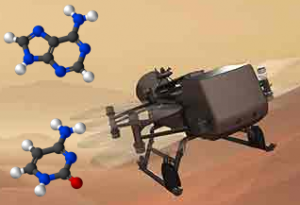UORG success!
October 1, 2019
We are excited to announce that the Ennis Group has been awarded a University of Otago Research Grant (UORG) for 2020. The funding will go towards commissioning new equipment to replicate the surface chemistry of the outer Solar System and uncover new pathways for the formation of nucleobases in planetary ices. Such chemistry is a main scientific target of the recently announced Dragonfly mission to Saturn moon Titan (arriving 2034) where an autonomous drone will sample the organic-rich landscape in search of these building-blocks of life.
Congratulations to Dr Rebecca Auchettl!
March 13, 2019
Massive congratulations to Dr Rebecca Auchettl who has been awarded her PhD by La Trobe University. Her thesis entitled:
“Synchrotron Spectroscopy of Astrochemical Condensed Phase Species: Terahertz/Far-Infrared Signatures of Planetary Aerosols and Ice”
featured laboratory work to characterise cyanide aerosols within Titan’s atmosphere; condensed icy materials that could harbour important biological precursors formed by radiation chemistry. These studies were carried out at the Far Infrared beamline at the Australian Synchrotron using spectroscopic equipment custom built to replicate the intriguing environment of this moon of Saturn. Well done Bec!!
The secrets of Titan: Cassini searched for the building blocks of life on Saturn’s largest moon
September 13, 2017
Check out my article in The Conversation talking about the presence of organic materials on Titan, published to coincide with the end of Cassini’s mission to the Saturnian system.
The Secrets of Titan: Recreating a Cyanide Sky
February 8, 2018
The Royal Society of Victoria Public Lecture – February, 2018
You can watch a recording of this presentation here: https://www.youtube.com/watch?v=41ml9gl53nk
The Cassini (NASA) mission to Saturn recently came to a spectacular end with the spacecraft burning up in the gas giant’s atmosphere after 13 years of close examination of Saturn’s icy moons and rings. The research of Dr Courtney Ennis and his colleagues concerns Saturn’s largest moon Titan, a world thought chemically reminiscent of an early-Earth, complete with extended atmosphere and weather driven by small hydrocarbons.
Here in the Titan sky, we have detected quantities of cyanide family compounds seasonally generated by sunlight. Although deadly to much life on Earth, these cyanide species could act as a source of life initiating molecules – such as amino acids and DNA bases – when exposed to Titan conditions. Join astrochemist Dr Courtney Ennis, who will discuss the implications of cyanides to the origins-of-life and present current work underway at the Australian Synchrotron, where a specialised experiment to mimic the Titan atmosphere has been used to recreate its cyanide rain.





